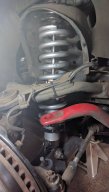parcou
Premium Member!
Premium Member
Hospitality Award
Rig of the Month Winner
Build Thread Contributor
- Messages
- 6,225
- Reaction score
- 9,127
- Location
- Memphis, TN
- Arrma RC's
- BigRock
- Felony
- Fireteam
- Granite
- Infraction
- Kraton EXB
- Talion EXB
- Typhon TLR
- Vorteks
Drill two holes the same diameter as a 2mm wrench in the A arms just like in this pic, problem instantly solved
For the newbie here, can you explain to me what are the front droop screws & function? I have an Infraction but this is a new term for me. I read a lot about lowering the Infraction by turning the shock screws or I guess doing this...what's correct. Thx


